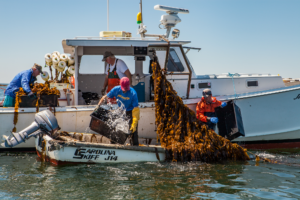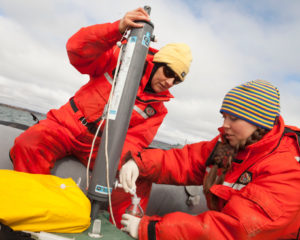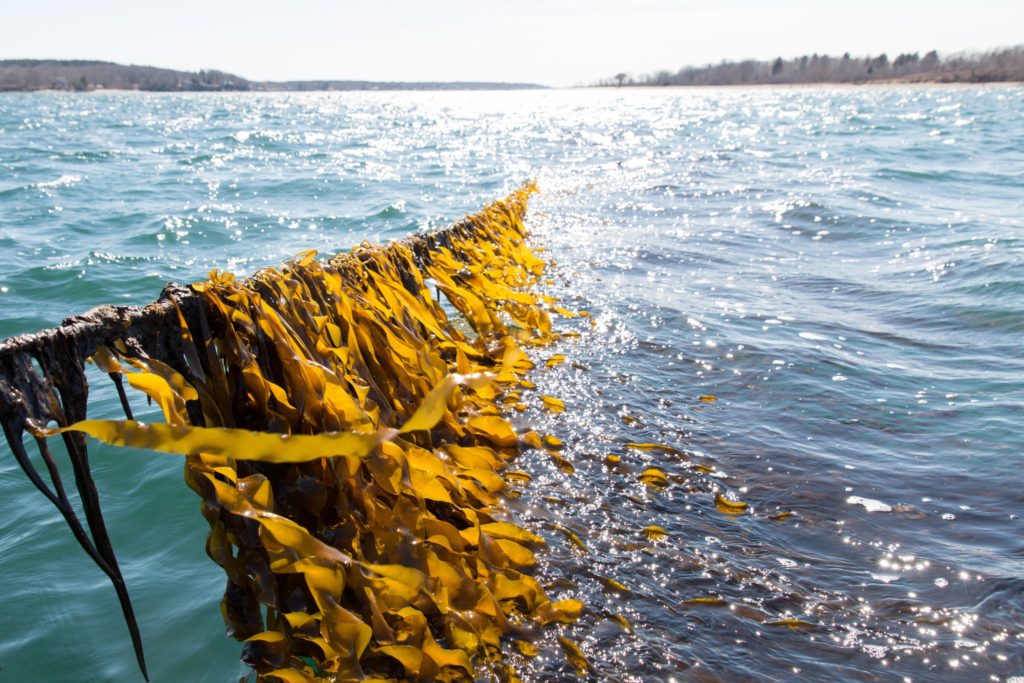With Earth Day around the corner, I would like to highlight a nascent industry on the Maine coast that is not only a boon for Maine’s marine economy, but is also good for the Earth. Kelp farming has emerged as a solid way for those making a living from the sea to earn supplemental income during the winter kelp growing season. Just over a year ago, Island Institute released an edible seaweed market analysis pointing to how investments in this sector could enhance Maine’s coastal economy by diversifying marine livelihoods and providing new supply-chain businesses and jobs. The report estimated that the 2019 level of farmed seaweed (325,000 wet pounds) could increase to between 1,540,000 and 5,965,000 pounds by 2035, with a best estimate of 3,060,000 pounds.
With the expansion of this industry, a great deal of research is underway to understand all of the potential ways that kelp farming can actually help fight climate change and improve local water quality. The Maine Climate Action plan called for State support for the growing aquaculture sector, not just to increase seafood production, provide economic opportunities for coastal communities, but also for its environmental services. It specifically calls out kelp’s ability to provide nature-based solutions to climate change.

Since 2015, I have partnered with Dr. Nichole Price’s team at Bigelow Laboratory for Ocean Sciences, and industry partners Atlantic Sea Farms and Bangs Island Mussels, to determine whether kelp farming can remediate ocean acidification and improve growing conditions for nearby shellfish. It is well known that land plants, through the process of photosynthesis, remove carbon dioxide from the air. We wanted to understand if kelp could remove enough carbon dioxide from the water, the major cause of ocean acidification, to improve water chemistry in and around the farm. During our first season of field research at the kelp farm off of Chebeague Island, through the use of moored scientific instruments measuring water chemistry, our data indicate higher pH (decreased acidity) inside the kelp farm. In subsequent seasons, we partnered with the University of New Hampshire (UNH), and using shipboard instruments mapped the water chemistry in and around the farm to determine the spatial extent of the remediated “halo” of water. Finally, we outplanted farmed mussels from Bangs Island Mussels inside and outside the kelp farm and determined that mussels growing inside the farm had thicker and denser shells and were harder to break. In part due to these research findings, Bangs Island Mussels now grows kelp around their mussels at one site, and hopes to add kelp to other mussel sites in the future. Our research team is now working with kelp farms in Alaska and Norway to share our methodology and successes and understand the generality of our findings.
This same Maine team is now also involved in an international effort, led by Oceans 2050 and Dr. Carlos Duarte, to quantify long-term carbon burial in sediments below seaweed farms. This global effort includes 19 seaweed farms from 12 countries and 5 continents. Earlier research by Dr. Duarte determined on average 16% of seaweed biomass (that which is sloughed off as it grows) is buried. Bigelow and the University of Maine (UMaine) have taken cores from the sediments beneath the farm off of Chebeague Island, the longest standing kelp farm in the United States. Essentially, the project will calculate carbon burial in sediments below seaweed farms around the world, some which have been in place for centuries, to test and quantify the carbon sequestration role of seaweed farms in mitigating climate change and as a step towards potentially creating a carbon credit system.

The Maine Climate Action plan called for further exploration of innovative solutions like opportunities for seaweed aquaculture to enhance long-term carbon burial and to support targeted reductions of coastal acidification. It also suggests exploring the opportunity for formal blue-carbon storage incentives or a carbon-permit program to encourage blue-carbon habitat conservation and restoration. If a carbon market was devised for kelp, it could provide added monetary benefits for Maine kelp farmers.
Kelp also provides lesser-known services that could mitigate climate change and improve local water quality. Bigelow Laboratory is at the forefront of researching these areas.
Kelp can pack a climate mitigation punch as a food additive for cows. Microbes called methanogens in cows’ rumens (one part of their elaborate four-part stomach) help to break down the grasses that cows eat, but the byproduct is methane-rich burps. With about a billion cows on the planet, not to mention the sheep, goats, and other “ruminants”, all burping away, livestock are the single biggest source of methane, which is a potent greenhouse gas. A University of California at Davis study found a diet made up of just 1% seaweed led to a 67% reduction of methane emissions in dairy cows and up to an 80% reduction in beef cows. Bigelow is working with Wolfe’s Neck Center for Agriculture and the Environment, Colby College, UNH, and the University of Vermont to trial Maine seaweeds on Maine cows. The team is studying what Maine seaweeds can effectively reduce methane, as well as improve the health of the cows and the soil where they graze.
My last example doesn’t involve eating kelp. It is sort of the reverse. Not quite kelp eating you, but kelp taking up what you ate. Kelp farmed for bioextraction is a whole different ball game. Kelp grown for this purpose would be nowhere near the kelp grown in clean waters for human consumption. I mention it, because it is another superpower of kelp that can help the planet. I’ve discussed how kelp can take up excess carbon dioxide in the water, but it also takes up nitrogen. Excess nitrogen in coastal areas causes big problems, like algal blooms, low oxygen, and even fish kills in a process called eutrophication. Kelp farmed at the location of wastewater treatment plant outfalls or other point source locations could actually remove some of the nitrogen not removed in the treatment process. This kelp could then be used for something other than eating, like fertilizer. While at UMaine, Dr. Gretchen Grebe and colleagues found kelp farms in Maine removed 17-157 pounds of nitrogen per acre of farm, depending upon the cultivation density of a farm and when the kelp was harvested in the spring. This is a huge range, and even on the high end, is less than some large treatment plants put out in single day, but points to the potential of strategically citing kelp farms near wastewater discharges in proximity to sensitive resources. Bigelow Laboratory is exploring the feasibility of growing kelp for excess nutrient removal in both Casco Bay and Boothbay Harbor.
A couple of challenges do face the expansion of the kelp aquaculture industry in Maine. Social acceptance of leasing small sections of ocean space for farms is critical. And, simply, enhanced awareness that kelp is both delicious and healthy will help with market demand. Maine waters provide the perfect conditions for growing quality sea vegetables locally. Maine aquaculturists have proven they are good at it. Let’s support these Maine innovators by spreading the word about kelp being good for you, good for coastal communities, and good for the planet.


